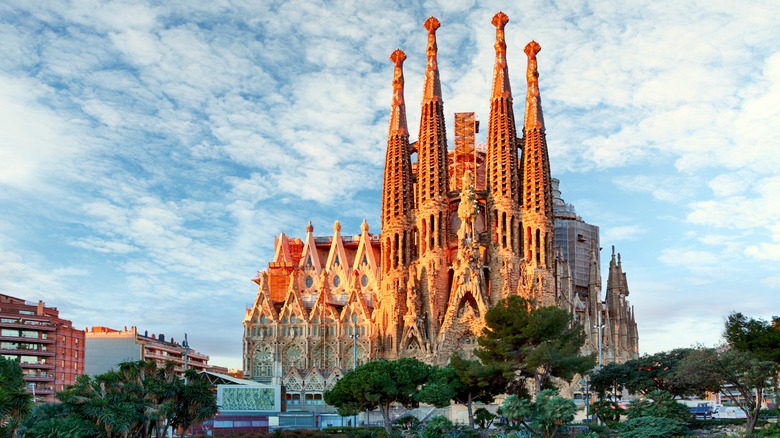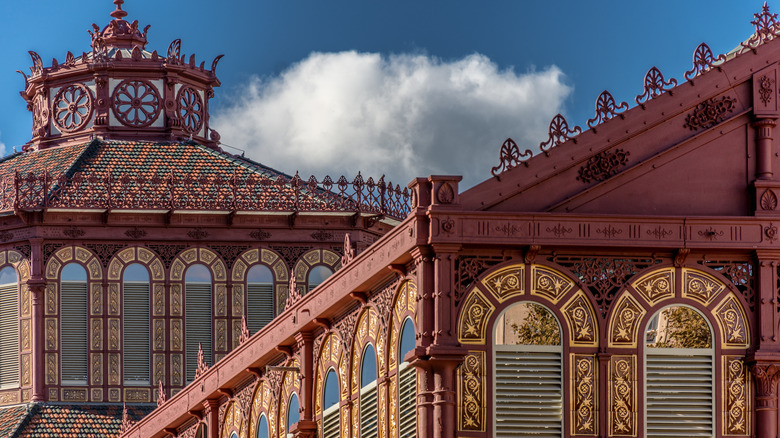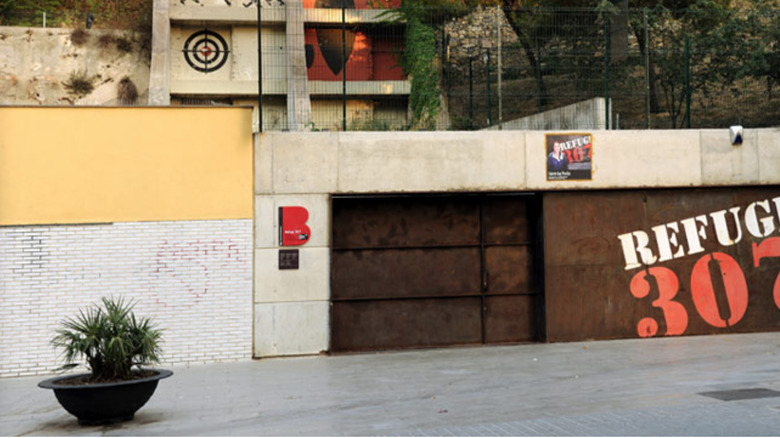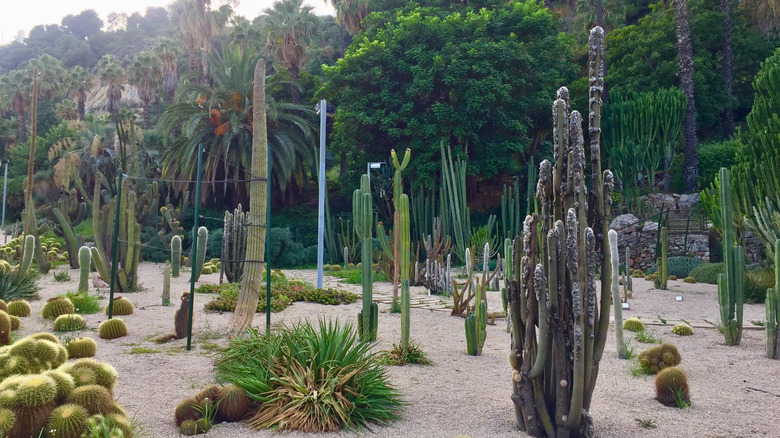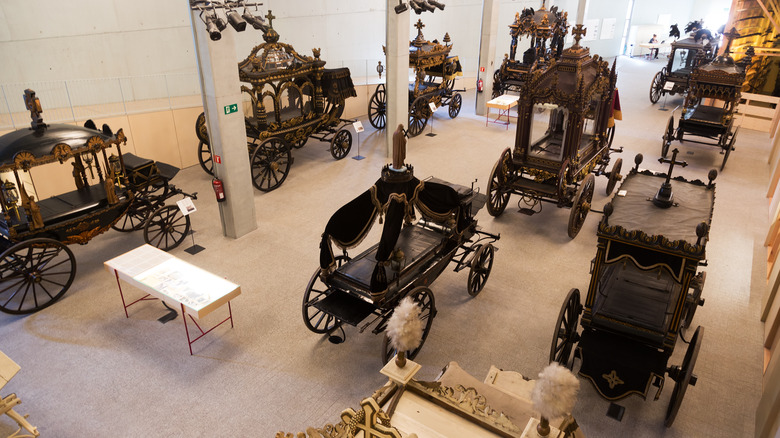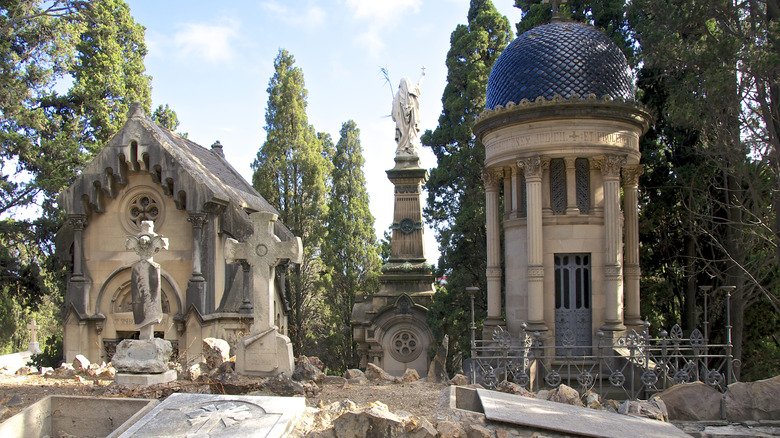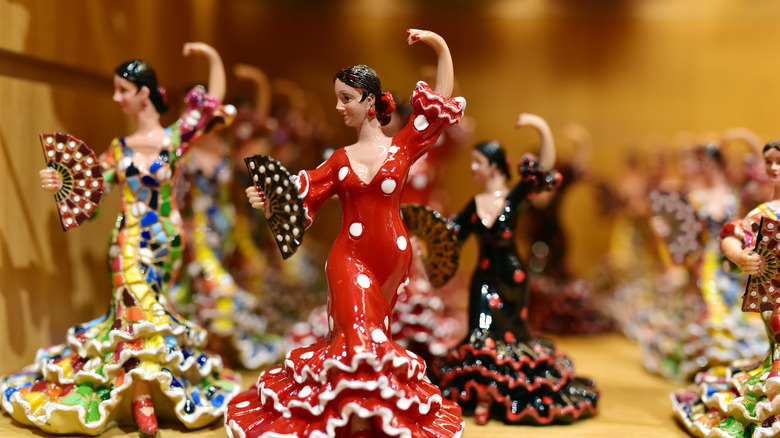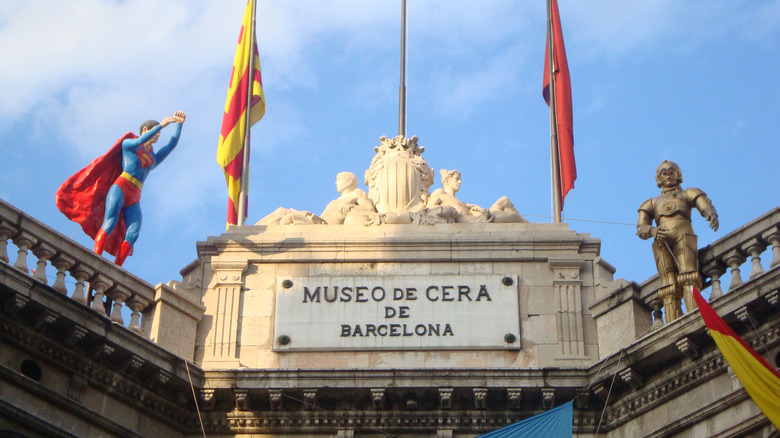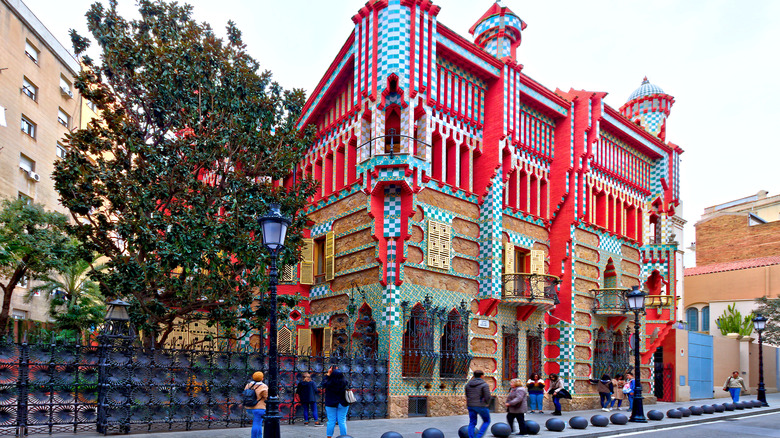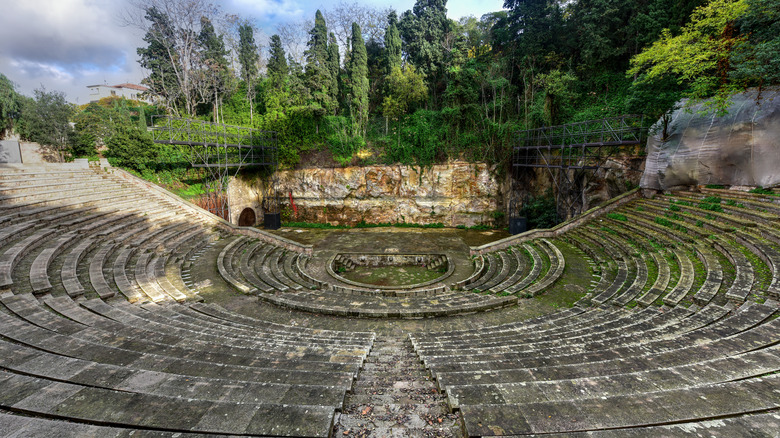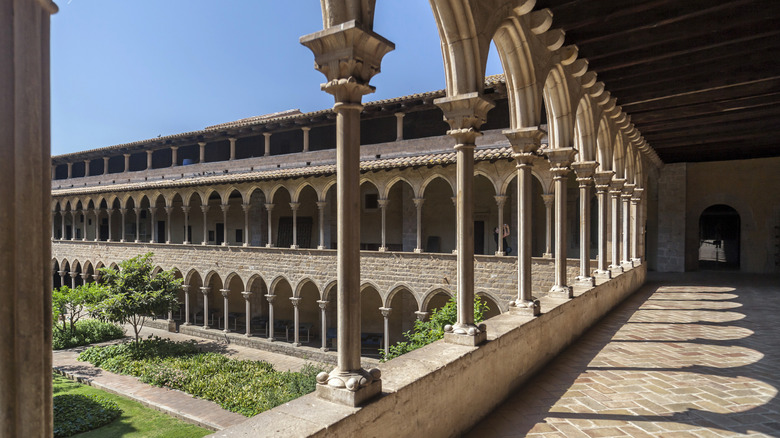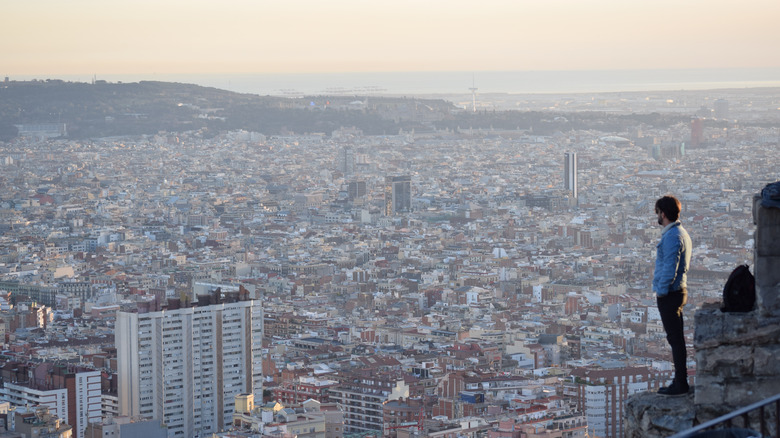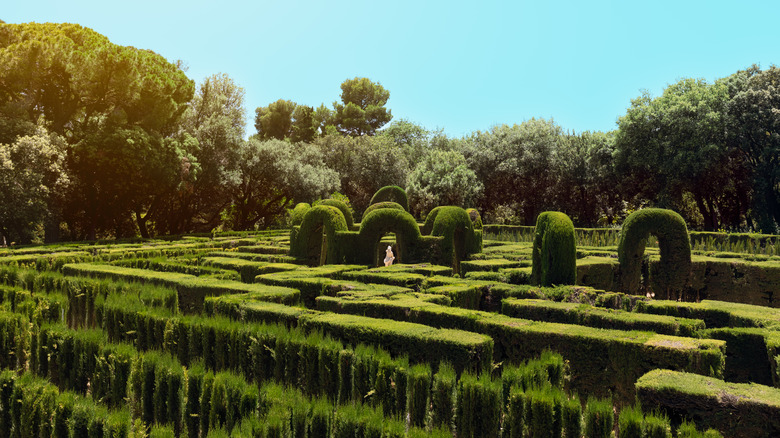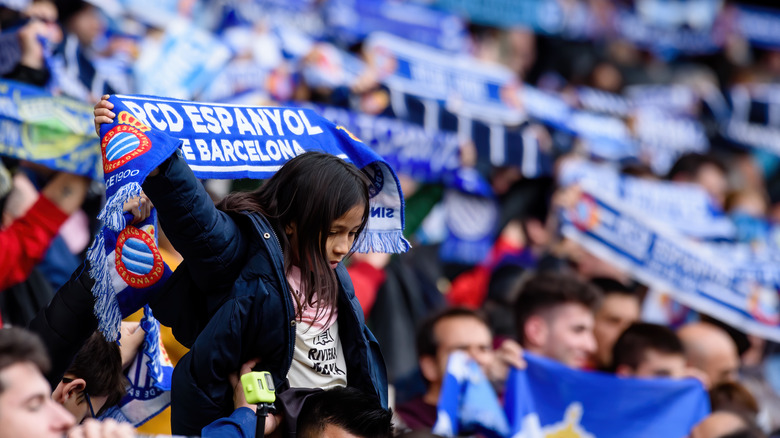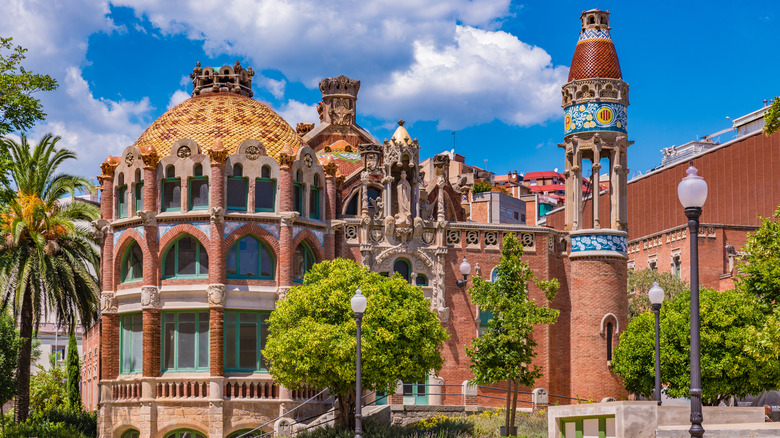Underrated Attractions In Barcelona To Add To Your Bucket List
Spain's center for art and gastronomy — and some might argue soccer! — Barcelona is a scintillating city that hugs the coastline of Catalonia. With its Mediterranean setting, and a temperate climate (yes, it gets hot in the summer but winters are amazingly pleasant), this cosmopolitan metropolis feels both like a city and a beachside escape.
There is so much to admire here, from the fantastic cultural institutions to the excellent shopping, from fabulous food to the breathtaking coast. There's also incredible architecture around the city, including the city's iconic La Sagrada Familia, an unfinished, four-towered Gothic church designed by Antoni Gaudí, and whose origin dates to the 1880s. Yet, for the multitude of well-known sights and diversions around the city, there are scores of others, lesser known, that are equally captivating — buildings, destinations, gardens, and places of nature that might be off the typical tourist radar, but are definitely worth seeking out. Below, are some of the best.
Carretera de les Aigües
With a name that translates to water road, this trail sits in the southerly part of the Parc Natural de la Serra Collserola, and is situated on what was the route of water pipes that supplied the city with that invaluable commodity. It's a fine piece of outdoors close to the urban spread, used for walking and biking, extending more than six miles and rising to a height to almost 1,500 feet above sea level.
The elevation makes this a great spot for a workout, for the chance to breathe lungfuls of fresh air, and of course for fabulous views of Barcelona, the entire breadth of the city neatly laid out in front of you, bookended by the rolling sea. The park is hugely popular with locals, so it's advisable to visit during the week, when it's noticeably less busy — weekends here are as packed as you'd expect for any large slice of city greenery.
Mercat de Sant Antoni
Most tourists know about the famous Mercat de la Boqueria, and for good reason — it's a bustling market located right on the city's most famous thoroughfare, Las Ramblas. Yet, for that very reason, it feels a little too commercial, a bit more suitable for phone-toting outsiders than bona fide locals looking for key ingredients for their evening meal.
For an altogether more authentic, and more off-the-radar, mercantile experience, head to Mercat de Sant Antoni, named for the central neighborhood where it's located. This is firmly a place filled with locals, a steel building designed by Catalan architect Antoni Rovira i Trias in the late 1800s that promises fabulous people watching. The selection of goods sold is equally fascinating, everything from fruits and vegetables to fresh meats and local seafood, from antique literary tomes to rare philatelic finds, though just wandering the lanes and stalls is a joy.
Granja Xocolateria La Pallaresa
What sweet treats are more compatible than hot chocolate and churros, a dizzyingly perfect combination of smooth, silky heat and crispy, crunchy, cinnamon confection. Hard to argue with that, right? Even better, these are specialties at this spot (sometimes referred to as La Pallaresa Xocolateria Xurreria) that's surprisingly authentic despite its central location — it's across the road from Mercat de la Boqueria and close to the Cathedral of Barcelona and the city's Erotic Museum.
Though churros and hot chocolate are huge draws, the menu offers a giant selection of drinks and nibbles guaranteed to kick-start your engine and keep it going. Think three varieties of hot chocolate (Spanish, Swiss, French), Catalan cream dessert, Viennese coffee, and lactose-free chufa milk. Thankfully the place isn't overrun with tourists, and remains popular with locals that drop by the narrow alley where it's sited to fuel up for the morning, or come for some daytime sustenance.
MUHBA — Refugi 307
The terror inflicted on Spain's populace by the actions of General Francisco Franco during the Spanish Civil War is a blot in Spanish history, a period that left the country financially and emotionally drained. The war also spurred the use of air raid shelters in towns and cities throughout the nation, like the one that is today Refugi 307.
Part of MUHBA — the Museum of History of Barcelona, which has a number of sites around the city — this sobering subterranean refuge is just one of 1,000 such shelters built in the city (hence the number in its name). A trip here lets travelers revisit the past and grasp the experience of Barcelonians during Franco's savage attack on the city, when his army led almost 200 bombing raids here. In scope, it features three entrances, is 400 meters in length, and rises to a height well over six feet.
Jardins de Mossèn Costa i Llobera
Lush green plants and fragrant flowers are some of the floral highlights that travelers to Barcelona can expect to encounter, with the city home to many spaces that are green year-round. Cacti, however, aren't something anyone would automatically associate with this Mediterranean melting pot — it's more likely to be found in the Desert of Tabernas, near the city of Almería — but plenty of them are on display at Jardins de Mossèn Costa i Llobera.
The views of the city alone are worth the visit, but what's more impressive is the range of cacti and succulent plants. The brainchild of an architect and plant expert, this garden has items from deserts, sub-deserts, tropical areas, and high alpine regions. Expect to see aloes from South Africa, cacti from Mexico, South America, and the American West, and grass trees from Australia at this destination that first opened in 1970.
Colección de Carrozas Fúnebres
Also launched in 1970, the collection of horse-drawn carriages makes this museum something unique, a way to quietly, seamlessly slip into a bygone time. The assemblage of vehicles here includes 13 that were used for funerals, others that were part of the procession, and a trio of motorised methods of transportation.
In addition to allowing guests to pore over beautifully intricate wheeled mechanisms from the 19th and 20th centuries used to transfer the dead to their final resting place, the museum explores the concepts of last rites and the symbolism of these carriages. They really are mobile works of art, as spectacular as anything hung in a gallery or traditional museum. The facility also houses thousands of books that delve into the topic of funerals — a subject that's little discussed and often considered taboo — looking at the way they have evolved from prehistoric eras to modern day.
Cementiri de Montjuïc
Named for the hill that dominates the landscape around the port, and that is home to a commanding castle built in the 1600s, this cemetery might seem like a strange choice for a visit, but there is actually is plenty to see. The cemetery was first opened in 1883 by the mayor of the city, with the first official tenant arriving that year, a politician from Cuba whose grave can still be visited.
Beyond being the site of scores of graves, the cemetery is home to a wide range of burial styles, from grand mausoleums in neo-Gothic style to simple graves adorned by statues of saints, from family vaults to graves of family members placed methodically on top of each other. More than 150,000 people are buried here, including the founder of FC Barcelona soccer club Joan Gamper and Catalan artist Joan Miró.
Estudi d'Oleguer Junyent
Spain is known as the spawning ground for many renowned painters throughout history — Diego Velázquez, Francisco Goya, Salvador Dali, Joan Miró (also buried in the city, as noted in the previous slide), and of course Pablo Picasso, who honed his craft at Barcelona's La Llotja art school. But how about contemporary and friend of Picasso, Oleguer Junyent? Who, you might ask? Visit this amazing studio, a fascinating window into his life and work, and you'll wonder how you've never heard of this prolific talent.
Having studied at the same academy in Barcelona as Picasso, Junyent was perhaps most famous for his pieces for theatrical productions, often used in the performing arts space Gran Teatre del Liceu (close to the Mercat de la Boqueria). Junyent was also an avid collector of art, and his studio also plays home to a trove of Catalan medieval art. On the upper floor, visitors will find a collection of dolls, some dating to the 17th century, and clothing made by his late niece Maria Junyent, a theatrical costume designer.
Museu de Cera
This wax museum isn't new, but even to repeat visitors it might seem so — the institution was closed during the early days of the pandemic and given a complete renovation, reopening on December 4, 2020. Today a visit here takes in 28 rooms arranged by themes, and wax figures of household names from the spheres of movies, music, sport, politics, history, and more. There are representations that appeal to international tourists as well as to locals, hence subjects like Brad Pitt, Lionel Messi, Billie Eilish, as well as Spanish luminaries like the Roca brothers (star chefs), basketball legend Pau Gasol, and Úrsula Corberó of "Money Heist" fame.
After a visit to the waxworks, have a drink next door at El Bosc de les Fades Cafe (it means Forest of the Fairies Cafe), a small gem that recreates an elfin wonderland, and feels a million miles from the city. A 10-minute walk away, Palacio de la Virreina is a stunning example of French Baroque architecture.
La Casa Vicens
The imprint of Antoni Gaudí is apparent on many buildings across the city, his signature fantasy mixture of Art Nouveau and neo-Gothic visible in the soaring La Sagrada Familia (where is he also buried, in the crypt), the trippy curves of Casa Mila, and the otherworldly textural vernacular of Casa Battló. But one space that is less well known is nevertheless vitally important in his canon of work. La Casa Vicens is conspicuous as the architect's first house.
The project was a commission by a financial broker for a summer garden home, and Gaudí worked on the building from 1883-1885. Its footprint was subsequently expanded by another architect some decades later, and a garden added. Today, the house, with an arresting red exterior accented by checked tile work is a city landmark, a Unesco World Heritage site, and a hugely underrated museum, with timed tickets required for entry.
Teatre Grec
Sitting on the curved step seats of Teatre Grec, you can almost imagine a Greek tragedy being performed here centuries ago, serious-looking actors staring earnestly at the rapt audience. While it looks healthily ancient, this Greek amphitheater was actually built in the 1920s for an international expo. Its terraced seating cleverly follows the contours of the setting, on a slope in hilly Montjuïc Park, and it was explicitly constructed for the purpose of a performance venue, first opening at 1929's Barcelona International Exposition.
The theater sits on the bones of an abandoned quarry, and the design of this arena was inspired by the Ancient Theatre of Epidaurus, in Greece's Peleponnese peninsula, a beautifully preserved piece of architecture. While the theater might appear like a relic, especially when nobody is around, it is used for shows, most famously during the city's annual Grec Festival, where music, dance, plays, and circus play to packed crowds.
Reial Monestir de Santa Maria de Pedralbes
There is a special feeling you get from visiting a monastery — one of hushed awe, a sense that the walls around you have witnessed deep history and deeper spiritual practice. Such sentiments are apparent at this monastery in the west of the city, which functions for its intended religious purpose, but also opens for visits from the public six days of the week.
Guests can enjoy a series of exhibitions during a trip here. A furniture show displays items like those donated by the monastery's founder, dating to the 14th century, and offers a window into the life and practices of the nuns that have lived here throughout those centuries. The green outdoors is beautifully presented with a look at the medicinal developments through Greek and Roman scientific practices, as well as a chance for guests to explore the large, walled medieval garden, where four plots are arranged to recreate their appearance in the Middle Ages.
Los Bunkers de Carmel
Most great views of the city, from places like Carretera de les Aigües, offer a peek of the metropolis from one direction. The vista here is unrivalled — quite possibly the best in the city — from a hilltop that was originally used as a site for anti-aircraft armaments during the Spanish Civil War. The hill called Turó de la Rovira, tops out at about 260 meters above sea level, and certainly has the feel of a remote, deserted outpost whose original purpose has long since faded.
It was originally where four Vickers guns were stationed, as a way to counter the carpet bombing inflicted on the city by troops loyal to Franco. Some time after the war ended, there were plans to develop the site, but none of them came to fruition. That loss has proved to be a gain for visitors and locals, with 360-degree views on offer, some from small barricaded walls that were where the guns once stood.
Carrer del Tallers
Every one in Barcelona, be they a visitor or a city resident, knows about Las Ramblas (also known at La Rambla), the tree-lined thoroughfare that is the pulsing core of the city, the equivalent of New York's Fifth Avenue, or Beverly Hills' Rodeo Drive, but without the elite cachet. These days Las Ramblas is a classic tourist stop to check off your list, but for some it represents everything that is wrong about tourism in the world, with overpriced cafes and tacky souvenir shops galore.
A far more interesting street experience is Carrer del Talles, an eclectic, narrow alley that branches off from Las Ramblas, but is often overlooked by tourists. Here, you'll find cute little cafes where the prices are affordable and restaurants aplenty. Other stops not to be missed are the numerous one-off, independent boutiques like the vinyl repository Revólver Records, and the sizable stock of vintage stores.
Sardana
The Cathedral of Barcelona is a sight that's high on many visitors' bucket list, and for good reason. It's a Gothic cynosure, whose construction began at the end of the 13th century on the site of an earlier, much more rudimentary basilica that stood there until the city was burned in 1046. The building took centuries to complete, with radial and lateral chapels, naves, a cloister, and an ornate facade that was finally finished in 1913.
Any time is worth visiting this architectural achievement, but perhaps no better moment is than on Sundays, around lunchtime, when the space in front of the cathedral plays host to locals performing the Catalan dance Sardana (every Sunday at noon). The performances involve groups arranged in circles, their hands raised, feet moving in intricate patterns. While the origins of the dance aren't clear, it is a symbol of local unity, and an enchanting piece of revelry to witness.
Parc del Laberint d'Horta
Some distance from the city center, though easy to get to by subway (close to the Mundet stop on the green L3 line), this slash of greenery front a huge piece of outdoors above the city, the Parc Natural de la Serra Collserola. Notable as being the city's oldest conservation garden, it is located on a former private estate of a Spanish noble, designed by a French landscaper in the early 1800s.
The labyrinth, or maze, is made from dense cypress hedges, and at the center of the maze — the heart of the puzzle — visitors will find a statue of Eros, the Greek god of love. In addition to this main showpiece, the park has plenty more to entertain. Domestic trees provide a pleasant range of foliage to admire, while the site also features a Neoclassical pavilion, small temples, a Chinese gate, elegant topiary art, and ponds with fountains.
RCD Espanyol
Soccer fans around the world will immediately recognize the name of the stadium Camp Nou — it's the home ground of FC Barcelona, the Spanish heavyweight where World Cup winner Lionel Messi spent much of his career and became a global superstar. Despite that club dominating the soccer scene here, the city does in fact have another club, RCD Espanyol, which also plays in the country's top league.
Tours here are also about half the price of those at the more famous club, though the experience is equally gratifying. During a trip round the stadium, fans can envision the pressures hoisted on coaches, the feeling of addressing a room full of expectant reporters, soak up the atmosphere of the dressing room, and calm their pre-match jitters walking down a tunnel before stepping onto the pitch. There's even a visit to the presidential box included, likely to make you feel like soccer royalty.
Recinte Modernista Sant Pau
An easy 10-minute walk north of La Sagrada Familia, the Recinte Modernista Sant Pau is a gem of Modernist architecture, and a Unesco World Heritage site. The hospital was designed by a master of Catalan Art Nouveau, Lluís Domènech i Montaner, expressly built to address the city's rapidly growing footprint and population at the end of the 19th century. Work began in 1902, with the separate buildings dedicated to their own medical genre. Ventilation and natural lighting were key components in the scheme (how forward-thinking), and when the Hospital de la Santa Creu i Sant Pau finally opened in 1930, it was done with the attendance of King Alfonso XIII.
The working inner functions of the hospital were moved in 2009 to a modern facility, and today this vast complex is a visual marvel, with palatial exteriors and even grander interiors — winding staircases, windowed hallways, intricately tiles domes, opulent archways, and sumptuous ceilings that look like they belong in a place of worship.
